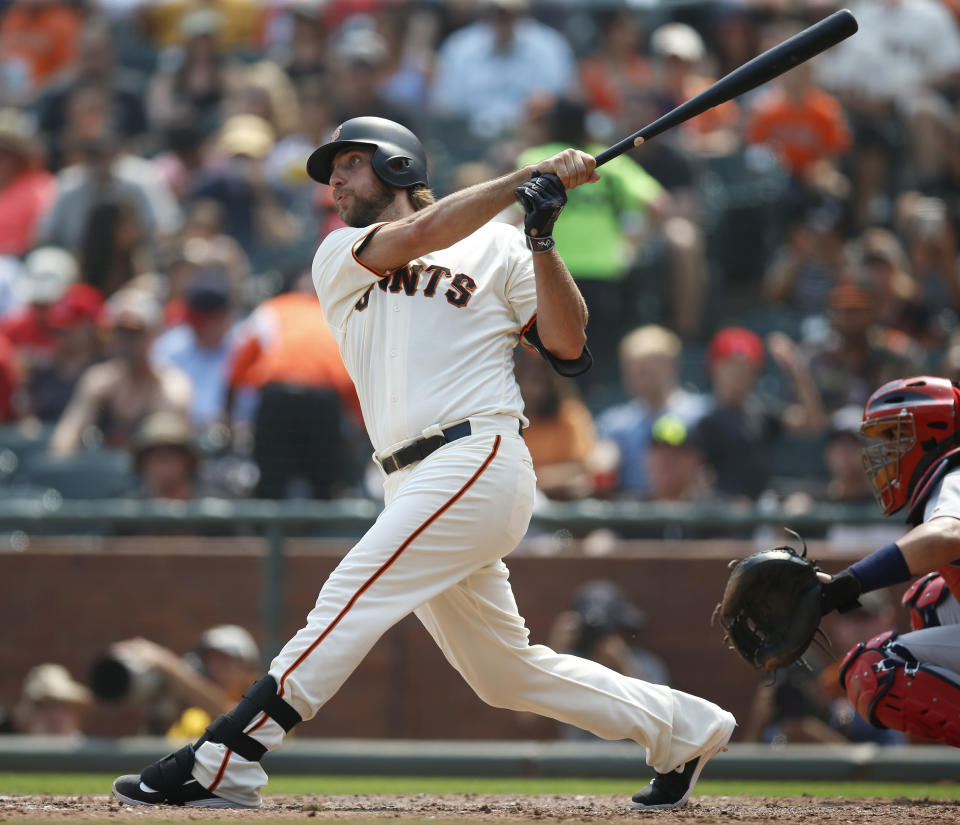Ruling on the rules: Should MLB make the universal DH permanent?
This week, with most of a shortened season in the rearview mirror, Yahoo Sports is reviewing the temporary rule changes MLB put in place for 2020. The question is simple: Should they stick around permanently?
[Ruling on the rules: The extra-innings rule]
Up next: The age-old, but now urgent argument over whether pitchers should ever have a place in the batting order. Is the universal DH here to stay?
Lose the universal DH
By Mark Townsend
I'll be the first to admit I've done some flip-flopping when it comes to the universal designated hitter. In general, I've become more open to MLB implementing significant changes after being a steadfast purist for much of my fandom. Before this season, that included finally accepting the seemingly inevitable universal DH.
Now though, after nearly two months of seeing a designated hitter in every single MLB game I’ve watched, I've come to realize two things:
First, I really do miss pitcher at-bats.
Beyond that, I'm not convinced giving offenses another advantage — even a marginal one — is necessary or beneficial for a league that is running through pitchers at an alarming rate.
Let’s first focus on the loss of pitcher at-bats. Baseball is definitely missing something without them. This really dawned on me when Madison Bumgarner returned to San Francisco a couple weeks ago. Of course, there were no fans in attendance for that specific game, but let's imagine there were. We’d be robbed of not only witnessing an incredible reaction as MadBum was introduced and stepped into the batter’s box. We’d also be robbed of him having the opportunity to go yard against the Giants, like he’d done so many times (19 to be exact) with the Giants.
Those are moments baseball needs more of. We need Madison Bumgarner hitting bombs against his former team. We need wildly entertaining hacks like those once provided by Bartolo Colon. We need the consequences that follow a manager’s decision to bunt or not pinch hit. It’s part of baseball’s fabric.

That’s one aspect. The loss of pitcher at-bats takes away another important element: The element of accountability.
We’ve seen several instances this season of pitchers making statements by throwing at batters. It’s so much easier for a pitcher to justify that approach in their mind knowing they won’t step in against a 100 MPH fastball. By no means am I endorsing throwing at a batter under any circumstances, and especially not at a pitcher, but the absence of accountability changes the dynamic.
I came to another realization while watching the Atlanta Braves rack up 29 runs against the Miami Marlins last week: There is such a thing as too much offense.
Don’t get me wrong. It’s fun to see a classic 16-15 slugfest every now and then. Those games have some appeal. But baseball is about more than offense. There’s pitching. There’s defense. There are moves and counter-moves, and counter-moves to counter-moves. If we move more toward designated hitters and offense and the potential for more slugfests, those other aspects move too far into the background.
Here’s another thing I noticed watching the Milwaukee Brewers score 19 runs the same day Atlanta scored 29 runs, and then watching the New York Mets score 18 runs in Buffalo: The pitching pool MLB teams are picking from is getting thin.
That’s not to take anything away from any pitcher who has reached the big leagues. It’s a massive achievement. It’s just, so many pitchers are being thrown into MLB games before they are ready or while operating at less than 100 percent. That’s not fun to watch. When a relief pitcher is forced to endure a 13-run outing, that is downright painful to watch.
Having a designated hitter makes those scenarios far more likely.
That Atlanta game, for example. Marcell Ozuna moved from left field to DH that night. That opened an opportunity for Adam Duvall, who responded with three home runs and nine RBIs. That’s good for Atlanta and Adam Duvall. It wasn’t good for Miami or for Jordan Yamamoto, the pitcher who was forced to throw 94 pitches in less than three innings, wear 13 runs and perhaps reassess where his career goes from here.
I understand why so many fans are on board with the universal DH. I understand that it extends careers for wonderful hitters like Nelson Cruz, which certainly isn’t a bad thing. I understand that it creates more jobs, which also isn’t a bad thing. Those are valid arguments for it.
I’m more in favor of the pitchers getting a little break, because they clearly need one. I’m fine with the occasional three-pitch strikeout of an opposing pitcher instead of watching an overmatched or exhausted hurler labor through four innings and 90 pitches knowing that a demotion is imminent. I want pitchers to get completely shelled less often so they’ll actually have a chance to establish themselves. I want baseball to be baseball, not an MTV Rock N’ Jock softball game.
I’m not suggesting MLB should take the designated hitter away from the American League. I’m saying one league is enough.
Keep the universal DH
By Chris Cwik
It’s the second inning and your favorite team has Clayton Kershaw on the ropes. It’s been a laborious inning. There are men on second and third and two outs. This next at-bat could drastically impact the outcome of the game. Get a hit, and you take a two-run lead against a dominant pitcher. Fail, and you let Kershaw regain his composure.
The broadcast pans over as the next batter approaches the plate. And your heart sinks. Dejected, you quietly whisper to yourself, “Is that … is that the pitcher?”
If there’s any positive to takeaway from sports in this hell year that has been 2020, it’s that no person will have to suffer through that scenario. As a result of the coronavirus-shortened season, MLB implemented a universal designated hitter in 2020. Here’s hoping the league does the right thing and makes the change permanent moving forward.
This is, incredibly, a controversial stance. People claim they actually enjoy watching pitchers hit .131/.162/.166 over a full season — which is what National League pitchers hit in 2019. Some fans love having a spot in the order that strikes out 43.1 percent of the time.
Now, reimagine the above scenario with a team using a universal DH. Instead of praying to the baseball gods the pitcher lucks into a base hit, you have hope. NL designated hitters are slashing .246/.328/.429 in 2020, giving your team a much better chance of cashing in against Kershaw.
Admittedly, I’m moving the goalposts here. People don’t actually enjoy watching pitchers hit. It’s a joyless, soul-sucking experience only tolerated by masochists. What the anti-DH crowd actually wants is more “strategy.” They pine for the days of manufactured offense — hit and runs, sacrifice bunts, stolen bases, etc. If a manager knows one spot in his order is an automatic out, he’ll have to employ some clever tactics to defeat his opponent, right?

In a word: No. Tony La Russa is long retired, and this isn’t the ‘80s. The tactics many NL fans grew to love no longer exist in today’s game. The emergence of advanced stats and sabermetric thinking have turned baseball into a numbers game. The goal is to be optimal, and that means managers don’t take those risks anymore. Giving up outs is a bad idea, so goodbye sac bunts. A caught stealing could drastically lower a team’s chance at scoring a run, so teams take fewer chances on the basepaths. Does this make for a scenario where 90 percent of managers are replaceable carbon copies of each other? It does. Is that good for the game? Probably not, but that’s how teams operate in 2020.
If you want true on-field strategy — which, let’s face it, just means you want to see your manager actually do things — you need to go back to 1985. That season, Gene Mauch’s California Angels led baseball with 96 sac bunt attempts. The league leader in 2019 — the Cleveland Indians — had 38 sac bunts. That total would have ranked 11th in 1985. We see the same trend with steals, where Whitey Herzog’s St. Louis Cardinals attempted to steal second base 324 times in 1985. The Seattle Mariners led baseball in that stat in 2019, attempting just 145 steals of second, which would have ranked 13th in 1985.
The only true on-field strategy being employed in 2020 is pitching changes. Starters aren’t going nearly as deep into games anymore. The New York Mets led baseball in 2019 with 5.8 innings pitched per start, according to Baseball-Reference. That figure would have ranked 22nd in 1985. Sure, allowing pitchers to hit might cause managers to employ even more pitching changes, but we’re already seeing a huge increase in that figure, and it’s not related to whether a team uses a DH. The five teams that ranked in the bottom of the league in innings pitched per start in 2019 all resided in the American League.
The type of strategy anti-DH proponents want doesn’t exist in today’s game. They have been in decline for years, even in the NL. The anti-DH brigade needs to face those facts. While they may find that depressing, at least they’ll never have to watch their favorite team’s pitcher weakly wave the bat at a slider four inches out of the zone again.
More from Yahoo Sports:

